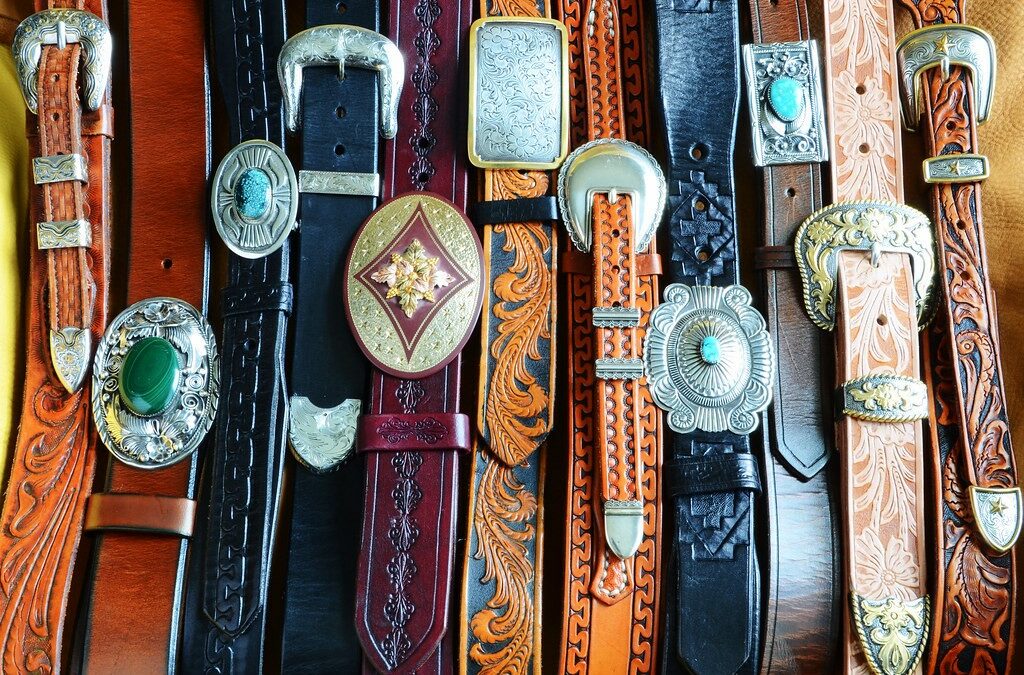When the Navajo began silversmithing, concho belts were one of the first pieces they created. As a popular piece of today’s American Western culture, the concho belt remains an enduring piece of Navajo jewelry and culture.
The concho design is so emblematic that conchos can now be seen in other jewelry styles, such as earrings, bracelets, and rings.
At Palms Trading Company, we offer jewelry styles featuring Navajo silver concho designs embedded with turquoise, coral, and other semi-precious stones. We want you to know the history behind concho belts and how they’re made.
Navajo Concho Belt Design
Navajo concho belts are a traditional form of Navajo jewelry. The belt consists of metal conchos or disks connected with a leather strap. The conchos are decorated with intricate patterns and designs that often represent natural elements such as animals, plants, and geometric shapes.
History of Concho Belts
The Spanish word for shell is concha, commonly translated into concho. It’s thought that these jewelry adornments acquired their name from resembling shells.
The Navajo people have a long and vibrant history which is still visible today in their culture and art. Their jewelry is particularly noteworthy, as the unique artistry found in traditional items such as concho belts has been passed down through generations.
Concho belts are one of the most iconic pieces of Navajo jewelry, and they tell an insightful story of the culture and its evolution. When describing the development of concho belts, most historians use phases to describe how concho belts evolved.
First Phase: Late 1860-1880
A Navajo man, Arsidi Chon (Ugly Smith), is credited for creating the initial concho belt in the southwestern American territories in the late 1860s. These conchos were made from Mexican silver pesos that were melted down and turned into ingots.
At this time, Navajos had yet to perfect soldering techniques, and thus these earliest conchos were round with diamond-shaped slots and a center bar to which the leather belt was threaded through.
This style became known as the first phase of concho belts and persisted from the late 1860s until 1880. They were characterized by their light silvery coloration plus scalloped edges lined with decorative circular holes punched inside them.
From the 1880s to 1890s, innovations in tools and stamps catalyzed a new level of creativity when designing conchos. With chisels, files, punches, and repoussé techniques becoming commonplace among artisans, intricate patterns were now possible.
Second Phase: Late 1800s-Early 1900s
During the second phase of concho belt evolution, silversmiths began to solder. In this period, either a copper or silver strap or bar was soldered onto the back of a concho so that leather belts could be threaded through it.
Initially, these straps were mostly made from silver. This allowed for more intricate decoration on the front of each concho while keeping leather belt details hidden behind it.
This transformation is believed to have occurred between the 1890s and early 1900s.
By the turn of the century, concho belts had become a status symbol among many Native American tribes. They were often gifted as tokens of love or friendship and worn to indicate a person’s wealth.
The intricate designs popularized during this period show that craftsmanship was highly valued in Navajo culture, with artisans creating stunningly detailed geometric patterns that are still recognizable today.
Third Phase: Early 1900s-1930s
During the third phase of concho belt development, a “butterfly” appears among the larger conchos. This butterfly was a smaller concho placed between two larger conchos to form its bow-like shape – resembling a butterfly. Additionally, turquoise became an ornamental inclusion on these mini conchos.
As time passed, copper bars on the back of conchos became more prevalent than silver bars.
Concho belts from these first 3 phases are often categorized as vintage belts. Anything newer is seen as merging into modern or contemporary styles.
Modern-Day Concho Belts: Late 1900s-Present
Today, concho belts have become a popular form of Navajo jewelry and fashion accessory among tribal and nontribal people worldwide. They can be found in many different styles, from traditional silver and turquoise designs to more modern pieces made of gold, diamonds, and other precious stones.
In addition to being a fashionable statement piece, concho belts are still commonly used in many tribal traditional ceremonies and celebrations, such as weddings and coming-of-age rituals.
Construction of Modern Concho Belts
Utilizing a keyhole puncher, a hole is created in the leather belt that is slightly smaller than the diameter of the concho screw. This creates an optimal fit.
The concho is screwed into the hole until its back is leveled with the leather. Some modern concho belt artisans add a bead or semi-precious stone, such as turquoise, to the center of each concho.
The screw cap is firmly secured to the screw with a pair of pliers, but the artist ensures there’s enough room for the leather belt to slide through.
Each concho is attached separately and pressed down firmly to ensure it’s secured.
The final step involves threading the two ends of the leather belt through the strap bar on the back of the first concho and using a belt buckle to secure it in place.
Where to Find Concho Belts and Other Navajo Jewelry
At Palms Trading Company, we proudly carry Navajo jewelry and concho belts in various motifs, styles, and colors. We offer both vintage pieces and modern designs, along with jewelry and pottery from other tribes and pueblos.
Our staff authenticates everything we carry, and we only buy our pieces directly from artisans.
Visit our Albuquerque store or shop online today to find your next piece of authentic Navajo jewelry!



